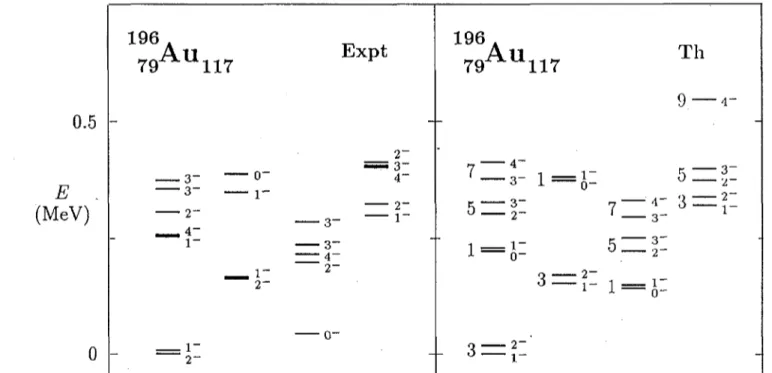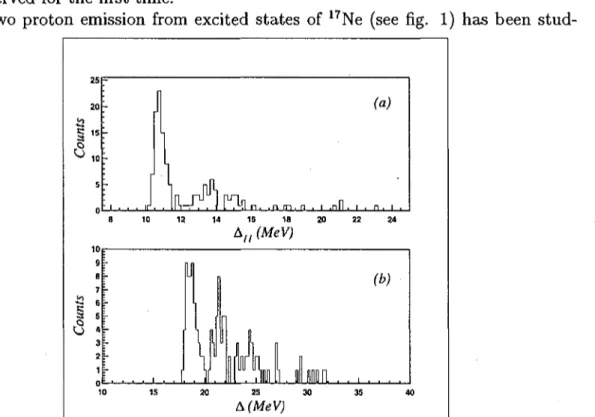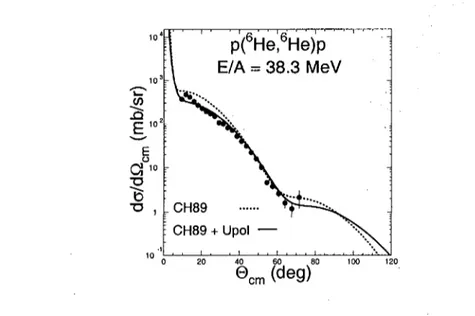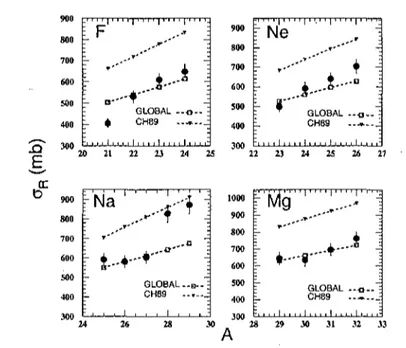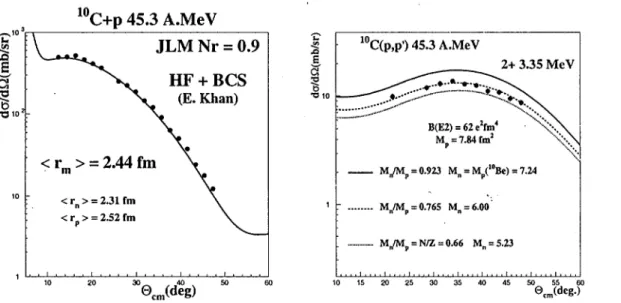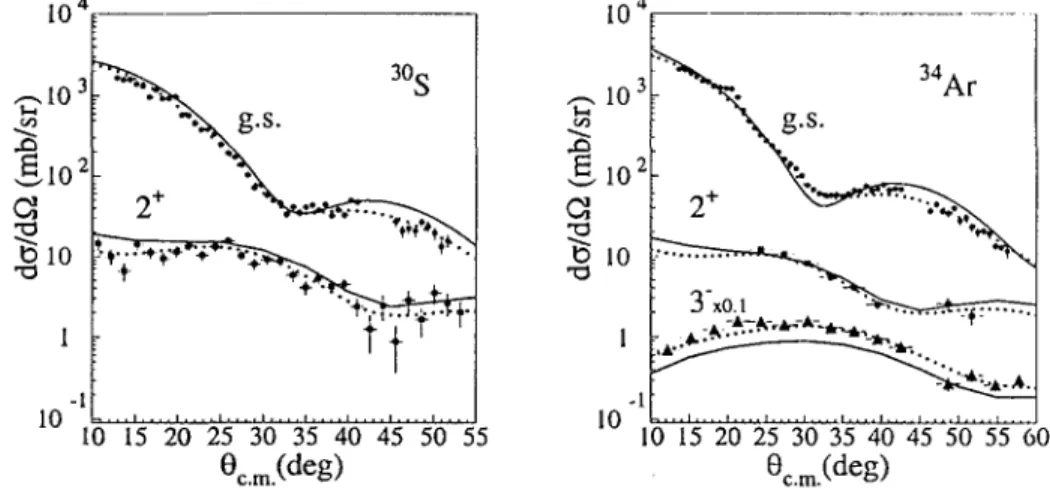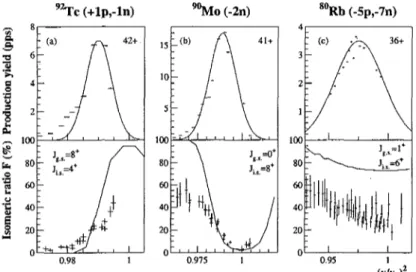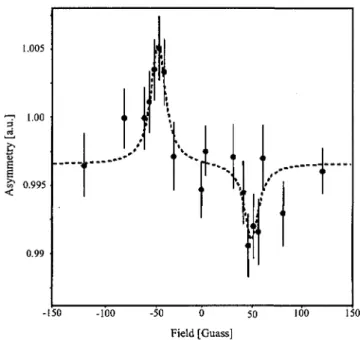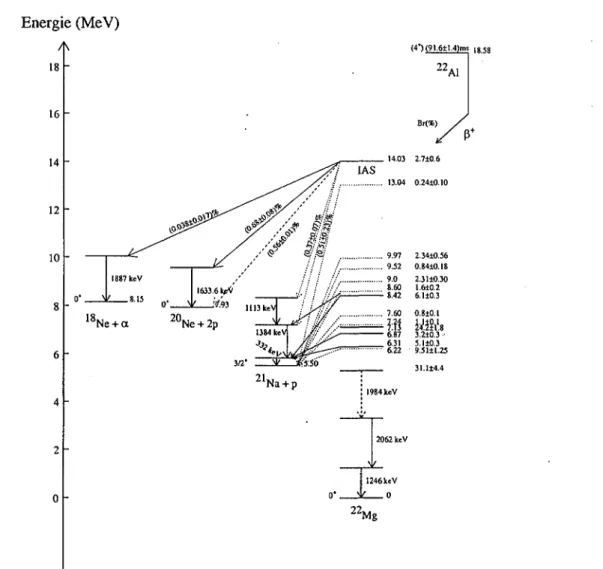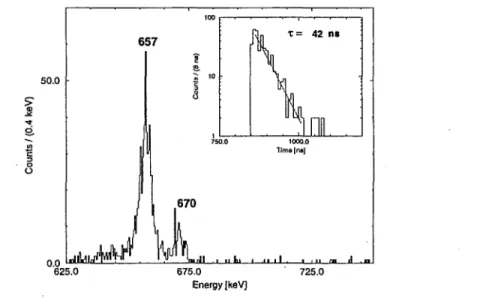HAL Id: in2p3-00383881
http://hal.in2p3.fr/in2p3-00383881
Submitted on 13 May 2009
HAL is a multi-disciplinary open access archive for the deposit and dissemination of sci-entific research documents, whether they are pub-lished or not. The documents may come from teaching and research institutions in France or abroad, or from public or private research centers.
L’archive ouverte pluridisciplinaire HAL, est destinée au dépôt et à la diffusion de documents scientifiques de niveau recherche, publiés ou non, émanant des établissements d’enseignement et de recherche français ou étrangers, des laboratoires publics ou privés.
Research at GANIL - A Compilation 1998-2000
J.D. Frankland, H. Rothard, M. Bex
To cite this version:
J.D. Frankland, H. Rothard, M. Bex. Research at GANIL - A Compilation 1998-2000. [Research Report] GANIL. 2002, pp.1-286. �in2p3-00383881�
FR0202297
Grand Accelerateur National d'lons Lourds
Laboratoire commun CEA / DSM - CNRS / IN
2
P
3
RESEARCH
ATGANIL
PLEASE BE AWARE THAT
ALL OF THE MISSING PAGES IN THIS DOCUMENT
WERE ORIGINALLY BLANK
I Gestion iNl
Doc. Enreg. le .&, i N* TRN .fcLCoX.'RESEARCH AT GANIL
A Compilation
1998 - 2000
Editors : J. Frankland, H, Rothard, M. Bex
Taping and layout of the manuscript: M. Campbell, S. Geswend
CONTENTS
FOREWORD
Summary
NUCLEAR PHYSICS
1-NUCLEAR THEORY
2 - EXOTIC NUCLEI: REACTIONS
3 - EXOTIC NUCLEI: SPECTROSCOPY
4 - HOT NUCLEI AND NUCLEAR MATTER
5 - INSTRUMENTATION
PUBLICATION LIST
INTERDISCIPLINARY RESEARCH
1 - INSTRUMENTATION
2 - COLLISIONS OF IONS WITH ATOMS AND MOLECULES
3 - COLLISIONS WITH SOLIDS AND SURFACES :
TRANSPORT PHENOMENA, ENERGY DEPOSITION
AND SPUTTERING
4 - INDUCED EFFECTS IN CONDENSED MATTER,
INCLUDING NANOSTRUCTURATION
5 - RADIATION CHEMISTRY AND RADIOBIOLOGIE
FOREWORD
The present compilation tends to reflect a variety of experimental and theoretical works
performed at GANIL in the years 1998-2000. This "just-before-SPIRAL" period was
characterized in nuclear physi.cs by a strong increase in the number of experiments dedicated
to the study of the structure of nuclei far from stability. The identification of the doubly-magic
48
Ni and study of the neighbouring nuclei are among the most spectacular results of this
research.
Another intriguing observation, the detection of the bound four-neutron cluster, if
confirmed, may become one of the greatest discoveries in nuclear physics of recent years.
Many interesting and often pioneering results were obtained in the study of nuclear halo and
the shell closures (N=20, 28 and 40) in the neutron rich nuclei. The shape coexistence in the
region of light Kr isotopes studied via isomeric states is one of the new and promising fields
of research at GANIL. These, and other not less interesting results in nuclear structure studies
were obtained using an impressive palette of experimental techniques including elastic and
inelastic scattering on light targets, direct and break-up reactions, neutron interferometry and
in-beam y-ray spectroscopy. Decay spectroscopy tools are becoming more and more
sophisticated and have allowed in particular for precision measurements of P-delayed
neutrons and protons, conversion electrons from isomers, as well as g-factors and
sub-nanosecond lifetimes of isomeric or excited states.
During this period the first experiments on the synthesis of heavy and super heavy
nuclei took place at the LISE spectrometer showing the existence of an important potential for
new discoveries and spectroscopic studies in this region of the chart of nuclei.
The first evidences for the observation of the liquid-gas phase transition of nuclear
matter marked studies of hot nuclei formed in nuclear collisions by the INDRA collaboration.
Sophisticated and original methods of data analysis as well as extensive theoretical
calculations allow to take full benefit of the different campaigns performed with this powerful
471 charged particle detector array. At lower excitation energies an original application of the
crystal blocking technique coupled with the 4TC neutron array ORION allowed to measure the
evolution of fission times in a previously inaccessible range.
Contributions concerning the SIRa test bench and the VAMOS and EXOGAM
spectrometers reflect the important efforts in R&D of the experimental equipment dedicated
to the new SPIRAL beams and experiments.
Last but not least, the interdisciplinary research at GANIL is in better shape than ever.
The proof is in the very important number of contributions dealing with swift heavy ions used
in atomic, solid state and condensed physics, in radiation chemistry and radiobiology. The
new equipment installed at the LIMBE lines, the IRRSUD irradiation facility and the
radiobiology laboratory currently under construction should ensure rapid progress and a
continuously increasing number of users in this domain in the coming years.
Dominique Goutte Marek Lewitowicz
I. NUCLEAR THEORY
DESCRIPTION OF EXOTIC NUCLEI USING THE SHELL MODEL EMBEDDED IN THE CONTINUUM
BENNACEUR K., MICHEL N., NOWACKIF., OKOLOWICZ J., PLOSZAJCZAK M.,
Strasbourg Collaboration 1
STATISTICAL ASPECT OF THE COUPLING TO THE CONTINUUM
DROZDZ S., OKOLOWICZ J., PLOSZAJCZAK M., ROTTER L, Strasbourg
Collaboration 2
PAIRING ANTI-HALO EFFECT
BENNACEUR K., DOBACZEWSKI J., PLOSZAJCZAK M., Warsaw Collaboration 3
DYNAMICAL SYMMETRIES IN QUANTAL MANY BODY SYSTEMS
VAN ISACKER P., GANIL - Caen 4
NUCLEAR SUPERSYMMETRY STANDS THE TEST
VAN ISACKER P., GANIL - Caen 6
PHASE TRANSITIONS IN FINITE SYSTEMS : CURVATURE ANOMALIES IN THE THERMODYNAMICAL POTENTIAL
GULMINELLI F., LPC - Caen
CHOMAZ Ph., DUFLOT V., GANIL - Caen 8
TOPOLOGY OF EVENT DISTRIBUTIONS AND PHASE TRANSITIONS IN FINITE SYSTEMS
GULMINELLI F., LPC - Caen
CHOMAZ Ph., DUFLOT V., GANIL - Caen 10
BIMODALITY IN NON-EXTENSIVE STATISTICS
GULMINELLI F., LPC - Caen
CHOMAZ Ph., DUFLOT V., GANIL - Caen 12
ANOMALOUS RADIAL EXPANSION OF NON-SPHERICAL SOURCE IN CENTRAL HEAVY-ION REACTIONS
LE FEVRE A., MORAWETZ K., PLOSZAJCZAK M., TONEEV V.D., GSI Collaboration 14
NUCLEAR MULTIFRAGMENTATION AND PHASE TRANSITIONS IN THE NON-EXTENSIVE STATISTICS
BOTET R., GONZALEZ J., GUDIMA K., PARVAN A.S., PLOSZAJCZAK M., TONEEV V.D., Orsay Collaboration 15
UNIVERSAL FEATURES OF FLUCTUATIONS
BOTET R., LPS Centre d'Orsay - Orsay
II. EXOTIC NUCLEI: REACTIONS
THE DETECTION OF NEUTRAL NUCLEI
MARQUES F.M., LABICHE M., ORR N.A., LPC - Caen 17
SEARCH FOR TWO PROTON EMISSION IN LIGHT NUCLEI AT THE PROTON DRIP LINE
ZERGUERRAS T., BEAUMEL D., BLUMENFELD Y., FALLOT M., LHENRY I., SCARPACI J.A., SHRIVASTAVA A., SUOMIJARVIT., IPN - Orsay
BLANK B., CHARTIER M., GIOVINNAZZO J., CEN.BG - Gradignan JOUANNE C , LAPOUX V., CEA Saclay - Gif-sur-Yvette
MITTIG W., ROUSSEL-CHOMAZ P., SAVAJOLS H., GANIL - Caen
THOENNESSEN M., MSU - East Lansing 18
MEASUREMENT OF THE CORRELATIONS IN THE nB E BREAKUP AND
EVIDENCES FOR THE TOWING MODE
SCARPACI J.A., BLUMENFELD Y., BOURGEOIS C , CHABOT M., DESESQUELLES P., DUPRAT J., FALLOT M., FRASCARIA N., GUILLEMAUD MUELLER D., SORLIN O.,
IPN - Orsay
LACROIX D., GREVY S., LPC - Caen
CHOMAZ Ph., DUFLOT V., ROUSSEL-CHOMAZ P., SAVAJOLS H., GANIL - Caen 20
CROSS SECTIONS, MOMENTUM DISTRIBUTIONS AND NEUTRON ANGULAR DISTRIBUTIONS FOR nB e INDUCED REACTIONS ON
SILICON
NEGOITA F., BORCEA C , CARSTOIU F., IFIN-HH - Bucharest-Magurele LEWITOWICZ M., SAINT-LAURENT M.G., ANNE R., GANIL - Caen
GUILLEMAUD-MUELLER D., MUELLER A.C., POUGHEON F., SORLIN O., IPN - Orsay FOMITCHEV A., LUKYANOV S-, PENIONZHKEVICH Yu.E., SKOBELEV N., FLNR JINR
- Dubna
DLOUHY Z., NPI - Rez 21
SEARCH FOR t+t CLUSTERING IN 6He
GIOT L., PITA S., ROUSSEL-CHOMAZ P., MITTIG W., DEMONCHY CH.E., PAKOU A., SAVAJOLS H., GANIL - Caen
TER AKOPIAN G., RODIN.A., STEPANTSOV S., WOLSKIR., FLNR JINR - Dubna ALAMANOS N., AUGER F., JOUANNE C , GILLIBERT A., LAPOUX V., NAPLAS L., POLLACCO E.C., SIDA J.L., CEA Saclay - Gif-sur-Yvette
CORTINA GIL M.D., FERNANDEZ J., Univ. de Santiago de Compostela - Santiago
de Compostela 23
COUPLING EFFECTS IN THE ELASTIC SCATTERING OF % e ON PROTON AND CARBON TARGETS
LAPOUX V., ALAMANOS N., AUGER F., FEKOU YOUMBI V., GILLIBERT A., MARIE F., OTTINI-HUSTACHE S., SIDA J.L., CEA Saclay - Gif-sur-Yvette
BLUMENFELD Y., Mac CORMICK M., MARECHAL F., SCARPACI JA., SUOMIJARVI T., IPN - Orsay
CASANDJIAN J.M., CHARTIER M., CORTINA-GIL M.D., MITTIG W., de OLIVEIRA SANTOS F., ROUSSEL-CHOMAZ P., GANIL - Caen
ORR N.A., LPC - Caen
KELLEY J.H., Duke Univ. - Durham KEMPER K.W., FSU - Tallahassee
OSTROWSKI A., Univ. of Edinburgh - Edinburgh
NEUTRON FEMTOMETRY AND CORRELATIONS IN THE HALO
MARQUES F.M., LABICHE M., ORR N.A., LPC - Caen 29
PROBING THE 6HE HALO STRUCTURE WITH ELASTIC AND INELASTIC
PROTON SCATTERING
LAGOYANNIS A., AUGER R, MUSUMARRA A., ALAMANOS N., POLLACCO E.C., BRAGA F., DROUART A., FIONI G., GILLIBERT A., LAPOUX V., OTTINI-HUSTACHE S., SIDA J.L., CEA Saclay - Gif-sur-Yvette
PAKOU A., Univ. ofloannina - lonnina
BLUMENFELD Y., KHAN E., SANTONOCITO D., SCARPACI J.A., SUOMIJARVI T., IPN
- Orsay
LA COMMARA M., PIERROUTSAKOU D., ROMOLIM., SANDOLIM., Univ. ofNapoli
and INFN - Napoli
MITTIG W., ROUSSEL-CHOMAZ P., GANIL - Caen 30
PROBING TWO-NEUTRON HALOES BY PROTON CAPTURE
SAUVAN E., MARQUES F.M., ORR N.A., LPC - Caen 33
REACTION CROSS SECTION AND INTERACTION POTENTIAL OF NEUTRON RICH NUCLEI ON PROTONS
de VISMES A., ROUSSEL-CHOMAZ P., MITTIG W., PAKOU A., CARSTOIU F., HIRATA D., DE OLIVEIRA SANTOS F., SARAZIN F., SAVAJOLS H., GANIL-Caen
ALAMANOS N., AUGER F., GILLIBERT A., LAPOUX V., MARIE F., MUSUMARRA A., OTTINI S., CEA Saclay - Gif-sur-Yvette
ANGELIQUE J.C., ORR N., LPC - Caen BARRETTE J., Me Gill Univ. - Montreal
BAUGE E., DELAROCHE J.P., CEA - Bruyeres-le-Chatel
BELOZYOROV A.V., LUKYANOV S.M., PENIONZHKEVICH Y.E., SKOVELEV N., FLNR
JINR - Dubna
BORCEA C , IAP - Bucharest
CATFORD W., Univ. of Surrey - Guildford
CORTINA-GIL M.D., Univ. of Santiago de Compostela - Santiago de Compostela
VLO\mYZ.,NPI-Rez
LEPINE-SZILY A., IFUSP - Sao Paulo 34
STUDY OF NEUTRON AND PROTON DEFORMATIONS IN 1 0C AND nC
JOUANNE C , LAPOUX V., ALAMANOS N., AUGER F., DROUART A., GILLIBERT A., LOBO G., NAPLAS L., POLLACCO E.C., SIDA J.L., CEA Saclay - Gif-sur-Yvette
BLUMENFELD Y., KHAN E., SUOMIJARVI T., ZERGUERRAS T., IPN - Orsay ROUSSEL-CHOMAZ P., SAVAJOLS H., GANIL - Caen
LAGOYANNIS A., PAKOU A., loannina Univ - loannina
MUSUMARRA A., INFN LNS - Catania 36
ELASTIC AND INELASTIC PROTON SCATTERING FROM THE UNSTABLE
3 0S AND 3 4Ar NUCLEI
KHAN E., SUOMIJARVI T., BLUMENFELD Y., NGUYEN VAN GIAI., BEAUMEL D., FORTIER S., FRASCARIA N., LHENRY I., MAISON J.M., PITA S., SANTONOCITO D., SCARPACI J.A., ZERGUERRAS T., IPN - Orsay
ALAMANOS N., AUGER F., DROUART A., GILLIBERT A., JOUANNE C , LAGOYANNIS A., LAPOUX V., MUSUMARRA A., OTTINI-HUSTACHE S. POLLACCO E.C., CEA
Saclay- Gif-sur-Yvette
DELBOURGO SALVADOR P., SAUVESTRE J.E., CEA- Bruyeres-le Chatel KEMPER K.W., MARECHAL R, FSU - Thallahassee
LEPINE SZILY A., IFUSP - Sao Paulo PIATELLI P., INFN LNS - Catania
INTERPLAY BETWEEN ANGULAR MOMENTUM TRANSFER AND NUCLEAR STRUCTURE IN THE PRODUCTION OF ISOMERS AT INTERMEDIATE ENERGIES
DAUGAS J.M., LEWITOWICZ M., LOPEZ JIMENEZ M.J., de OLIVEIRA SANTOS F.,
GANIL - Caen
NEYENS G., IKS Univ ofLeuven- Leuven GRZYWACZ R., Univ. of Tennessee - Knoxville ANGELIQUE J.C., LPC - Caen
AXELSSON L., Chalmers Tekniska Hogskola - Goteborg BORCEA C, IAP - Bucharest - Magurele
LONGOUR C , IReS - Strasbourg „ 40
NUCLEAR SPIN ALIGNMENT PRODUCED IN A PROJECTILE FRAGMENTATION REACTION
COULIER N., BALABANSKI D.L., BORREMANS D., COUSSEMENT R., DAUGAS J.M., GEORGIEV G., TEUGHELS S., VYVEY K., NEYENS G., IKS Univ ofLeuven - Leuven de OLIVEIRA SANTOS F., LEWITOWICZ M., MATEA I., STANOIU M., GANIL - Caen NAVILIAT CUNCIC O., LPC - Caen 42
SPIN POLARISATION OF 2 7Na AND 31A1 INTERMEDIATE ENERGY
PROJECTILE LIKE FRAGMENTS
DAUGAS J.M., BORREMANS D., TEUGHELS S., BALABANSKI D.L., COULIER N., COUSSEMENT R., GEORGIEV G., VYVEY K., NEYENS G., IKS Univ ofLeuven
-Leuven
HASS M., The Weizmann Inst - Rehovot
LEWITOWICZ M., MATEA I., de OLIVEIRA SANTOS F., STANOIU M., GANIL - Caen PENIONZHKEVICH Y.E., FLNR JINR - Dubna
SCHMIDT OTT W.D., Gottingen Univ. - Gottingen 44
EXPERIMENTS ON SUPER HEAVY NUCLEI PRODUCTION
AMAR N., ANGELIQUE J.C., FONTBONNE J.M., GREVY S., HANAPPE F., LEGOU T., LIENARD E., ORR N., PETER J., STECKMEYER J.C., TILLIER J., LPC - Caen
ANNE R., AUGER G., BECKER F., GUERREAU D., HUE R., LALLEMAN A.S., LECESNE N., LEWITOWICZ M., MITTIG W., de OLIVEIRA SANTOS F., SAINT-LAURENT M.G., STODEL C , de TOURREIL R. VILLARI A.C.C, WIELECZCO J.P., GANIL - Caen
ALAMANOS N., DAYRAS R., DROUART A., GILLIBERT A., POLLACCO E.C, CEN
Saclay - Gif-sur-Yvette
LICHTENTHALER R., IFUSP - Sao Paulo MAUNOURY L., CEA - Bruyeres-le-Chatel PLAGNOL E., IPN - Orsay
POLITI G., INFN - Catania
III. EXOTIC NUCLEI: SPECTROSCOPY
STUDY OF THE 22A1 /S -DECAY
ACHOURI N.L., LPC - Caen
de OLIVEIRA SANTOS F., LEWITOWICZ M., STANOIU M., TRINDER W., GANIL
-Caen
BLANK B., CZAJKOWSKIS., GIOVINAZZO J., LONGOUR C , THOMAS J.C., CENBG
-Gradignan
BERAUD R., CANCHEL G., EMSALLEM A., IPNL - Villeurbanne AYSTO J., JOKINEN A., Univ. ofJyvaskyla - Jyvaskyla
LAIRD A., OSTROWSKI A., Univ of Edinburgh - Edinburgh 49
DECAY SPECTROSCOPY WITH THE TONNERRE ARRAY
ACHOURI N.L., ANGELIQUE J.C., GREVY S., LECOLLEY F.R., LECOUEY J.L., LIENARD E., ORR N.A., PETER J., PIETRI S., LPC - Caen
BORCEA C , BUTA A., NEGOITA F., TIMIS C , IAP - Bucharest-Magurele
de OLIVEIRA SANTOS F., LEWITOWICZ M., STANOIU M., TARASOV O., GANIL
-Caen
BAUMANN P., COURTIN S., DESSAGNE P., HADELER R., KNIPPER A., MIEHE C , POIRIER E., WALTER G., IReS - Strasbourg
GUILLEMAUD MUELLER D., IPN - Orsay PENIONZHKEVICH Y.E., FLNR JINR - Dubna DLOUHY Z., MRAZEK J., NPI - Rez
DAUGAS J.M., IKS KU Leuven., Leuven
CATFORD W., Univ. of Surrey - Guilford 51
DECAY OF PROTON RICH NUCLEI BETWEEN 3 9Ti AND 4 9Ni
GIOVINAZZO J., BLANK B., CHARTIER M., CZAJKOWSKI S., PRAVIKOFF MS., THOMAS J.C., CEN.B - GRADIGNAN
BORCEA C , IAP - Bucarest-Magurele
de FRANCE G., LEWITOWICZ M., de OLIVEIRA SANTOS F., GANIL - Caen
GRZYMACZ R., JANAS Z., PFUTZNER M., IEP - Warsaw 53
A NEW SHAPE ISOMER IN THE N=Z NUCLEUS 7 2Kr
BECKER F., BOUCHEZ E., HAUSCHILD K., HURSTEL A., LE COZ Y., LUCAS R., REJMUND M., THEISEN CH., CEA - Saclay
de FRANCE G., LEWITOWICZ M., MATEA I., de OLIVEIRA SANTOS F., STANOIU M.,
GANIL - Caen
BLANK B., CENBG - Bordeaux
BORCEA C , BUTA A., NEGOITA F., PANTELICA D., IF1N - Bucarest EMSALLEM A., IPN - Lyon
GENEVEY J., PINSTON J., 1SN - Grenoble HANNACHI F., CSNSM - Bordeaux
RAHKILA P., Univ. ofJyvaskyla - Jyvaskyla 55
COUPLING OF VALENCE PARTICLES TO THE 7 0Ni CORE STUDIED VIA
MEASUREMENTS OF THE B(E2) STRENGTH IN 67,69,70Ni A N D 7 1C u
MACH H., FOGELBERG B., RAMSTROM E., ISV Uppsala Univ. - Nykoping
LEWITOWICZ M., STANOIU M., BECKER F., DE OLIVEIRA SANTOS F., GANIL - Caen BLOMQVIST J., CEDERWALL B., KLAMRA W., KTH - Stockholm
BORGE M.G., BOUTAMI R., FRAILE L.M., CISC - Madrid DLOUHY Z., MRAZEK J., NPI - Rez
GEORGIEV G., NEYENS G., IKS KU - Leuven GRAWE H., GSI - Darmstadt
PLUTZNER M., SAWICKA M., IFD Warsaw Univ. - Warsaw JOHANSSON P.I., NFL Uppsala Univ. - Nykoping
LUKYANOV S., PENIONZHKEVICH Yu.E., FLNR JINR - Dubna
MINEVA M.N., Lund Univ. - Lund 57
NEW SHORT LIVED ISOMERIC STATES IN NEUTRON RICH NUCLEI
FOLLOWING THE PROJECTILE FRAGMENTATION OF 8 6Kr BEAM
DAUGAS J.M., LEWITOWICZ M., BENNACEUR K., de FRANCE G., LOPEZ JIMENEZ M.J., de OLIVEIRA SANTOS F., STANOIU M., GANIL - Caen
GRZYWACZ R., BINGHAM C , Univ. of Tennessee - Knoxville
PFUTZNER M., RYKACZEWSKI., SAWICKA M., IFD- Warsaw Univ. - Warsaw ACHOURI L., ANGELIQUE J.C., LPC - Caen
BAIBORODIN D., NPI - Rez
BENTIDA R., BERAUD R., EMSALLEM A., IPN - Lyon BORCEA C , IAP - Bucarest-Magurele
CATFORD W.N., JONES K.L., LEMMON R.C., REGAN PH., Univ. of Surrey
-Guildford
GRAWE H., GSI - Darmstadt NOWACKI F., LPT - Strasbourg
SAUVESTRE J.E., CEA - Bruyeres-le-Chatel
SLETTEN G., NBI - Copenhagen 59
MEASUREMENTS OF ISOMERIC g-FACTORS FROM PROJECTILE FRAGMENTATION
GEORGIEV G., NEYENS G., BALABANSKI D.L., COULIER N., COUSSEMENT R., DAUGAS J.M., GORSKA M., SMIRNOVA N.A., TEUGHELS S., VYVEY K., Univ. of
Leuven - IKS - Leuven
de FRANCE G., LEWITOWICZ M., MATEA I., de OLIVEIRA SANTOS F., STANOIU M.,
GANIL - Caen
HASS M., GOLDRING G., The Weizmann Institute - Rehovot BINGHAM C , GRZYWACZ R., Univ of Tennessee - Knoxville BORCEA C , NIPNE - Bucarest
GRAWE H., GSI - Darmstadt
PFUTZNER M.( SAWICKA M., IEP - Warsaw
MACH H., ISV - Uppsala University - Nykoping PAGE R.D., Oliver Lodge University - Liverpool
PENIONZKEVICH Y.E., SOBOLEV YU., FLNR JINR - Dubna PODOLYAK ZS., REGAN PH., Univ. of Surrey - Guilford
RYKACZEWSKI K., ORNL - Oak Ridge 61
g-FACTOR AND SPIN OF 31A1 MEASURED WITH $ - NMR
BORREMANS D., NEYENS G., TEUGHELS S., BALABANSKI D.L., COULIER N., COUSSEMENT R., DAUGAS J.M., GEORGIEV G., SMIRNOVA N.A., VYVEY K., WEISSMAN L., Univ of Leuven-IKS- Leuven
ACHOURI L., de FRANCE G., de OLIVEIRA SANTOS F., de VISMES A., LEWITOWICZ M., MATEA I., ROUSSEL-CHOMAZ P., SAVAJOLS H., STANOIU M., TARASOV O.,
GANIL - Caen
PENIONZHKEVICH Y.E., SOBOLEV Y., FLNR JINR - Dubna
SCHMIDT OTT W.D., Universitat Gottingen - Gottingen 63
ELECTRIC AND NUCLEAR TRANSITION STRENGTH IN 30,32M g
ALAMANOS N., AUGER F., BRAGA F., GILLIBERT A., LAPOUX V., LIGUORI-NETO R., MARIE F., OTTINI-HUSTACHE S., SIDA J.L., CEA Saclay - Gif-sur-Yvette
LEPINE A., LICHTENTHALER R., Inst. de Fisc. Univ. Sao Paulo - Sao Paulo
CORTINA-GIL M.D., LEWITOWICZ M., de OLIVEIRA SANTOS F., ROUSSEL-CHOMAZ P., MITTIG W., GANIL - Caen
BARRETTE J., Me Gill Univ. - Montreal
OSTROWSKI A., Depart. ofPhys. & Astronomy Univ. of Edinburgh
-Edinburgh
PAKOU A., Univ. ofloannina - loannina
LUKYANOV S., PENIONZHKEVICH Y.E., FLNR JINR - Dubna DLOUHY Z., IPN - Rez
CHISTE V., Mac CORMICK ML, IPN - Orsay 65
BETA DECAY STUDIES OF NEUTRON-RICH NUCLEI AROUND N=40
SORLIN O., DONZAUD., AZAIEZ R, BOURGEOIS C , CHISTE V., GUILLEMAUD MUELLER D., IBRAHIM F., POUGHEON F., IPN - Orsay
ANGELIQUE J.C., GREVY S., LPC - Caen DLOUHY Z., MRASEK J., NPI - Rez
LEWITOWICZ M., de OLIVEIRA SANTOS F., SAINT-LAURENT M.G., STANOIU M.,
GANIL - Caen
LUKYANOV S., PENIONZHKEVICH Y.E., FLNR JINR - Dubna 67
MELTING OF THE N=28 SHELL CLOSURE IN NEUTRON RICH S AND Ar NUCLEI
SOHLER D., TIMAR J., DOMBRADI ZS., NYAKO B.M., INR - Debrecen
AZAIEZ F., SORLIN O., AMORINIF., BELLEGUIC M., BOURGEOIS C , DONZAUD C , DUPRAT J., GUILLEMAUD-MUELLER D., IBRAHIM F., PETIZON L., SCARPACI J.A., STODEL C , IPN - Orsay
STANOIU M., LOPEZ M.J., SAINT-LAURENT M.G., SARAZIN F., VOLTOLINI G.,
GANIL - Caen
BAIBORODIN D., LUKYANOV S.M., MASLOV V., PENIONZHKEVICH Y.E., FLNR
-JINR - Dubna
BAUCHET A., CSNSM - Orsay
BECKER F., THEISEN C , CEA Saclay - Gif-sur-Yvette BORCEA C , IAP - Bucarest-Maguerele
DLOUHY Z., MRAZEK J., NPI - Rez LUCAS R., IPN - Lyon - Villeurbanne
MOORE C , TAYLOR M., OLL Univ of Liverpool - Liverpool NOWACKIF., Univ L. Pasteur - Strasbourg
SLETTEN G., NBI- Copenhagen . 69
EVIDENCE OF DOUBLY MAGIC STRUCTURE IN 6 8Ni NUCLEUS
SORLIN O., LEENHARDT S., DONZAUD C , AZAIEZ R, AMORINI F., BELLEGUIC M., BOURGEOIS C , BRENNING H., DUPRAT J., GUILLEMAUD MUELLER D., PETIZON L., POUGHEON F.( SCARPACI J.A., IPN - Orsay
ASTIER A., REDON N., IPN - Lyon - Villeurbanne BAIBORODIN D., DLOUHY Z.( NPI - Rez
BIENCZAK K., LEWITOWICZ M., de OLIVEIRA SANTOS R, SAINT-LAURENT M.G., STANOIU M., GANIL - Caen
BORCEA C , DRAGULESCU E., IFIN-HH- Bucarest-Magurele DOMBRADI ZS., PANTELICA D., INR - Debrecen
GORSKA M., GRAWE H., MA YET P., GSI - Darmstadt GREVY S., LPC - Caen
HAGEMANN G., HERSKIND B., SLETTEN G., NBI - Copenhagen KIENER J., CSNSM - Orsay
LEMMON R., Univ. of Surrey - Guilford
LUKYANOV S.M., PENIONZHKEVICH Y.E., TARASOV O., FLNR JINR - Dubna Mac CULLEN D., Olivier Lodge Lab. - Liverpool
IV. HOT NUCLEI AND NUCLEAR MATTER
FINE STRUCTURE OF GIANT RESONANCES IN 2 0 8P b
DROUART A., ALAMANOS N., AUGER F., GILLIBERT A., JOUANNE C , LAPOUX V., LOBO G., POLLACCO E.C., SIDA J.L., CEA-Saclay - Gif-sur-Yvette
de VISMES A., MITTIG W., OTTINI-HUSTACHE S., ROUSSEL-CHOMAZ P., SARAZIN F., SAVAJOLS H., GANIL - Caen
FRASCARIA N., IPN - Orsay
LACROIX D., LPC - Caen - 73
MULTIPHONON DECAY MEASURED WITH THE INDRA PLUS SPEG ENSEMBLE
FALLOT M., FRASCARIA N., SCARPACI J.A., BLUMENFELD Y., DESESQUELLES P., KHAN E., PLAGNOL E., ROYNETTE J.C., ZERGUERRAS T., IPN - Orsay
CHBIHI A., CHOMAZ Ph., FRANKLAND J.D., ROUSSEL-CHOMAZ P., LAVILLE J.L.,
GANIL - Caen
POLLACCO E.C., CEA - Gif-sur-Yvette 76
FISSION TIME OF HEAVY NUCLEI
BASNARY S., CHBIHI A., FRANKLAND J.D., MORJEAN M., GANIL - Caen
BARRUE F., CHEVALLIER M., DAUVERGNE D., KIRSCH R., LAUTESSE P., POIZAT J.C., IPN Lyon - Villeurbanne
COHEN C , ELLMER H;, GUIGNER J;M., L'HOIR A., GPS - Paris JACQUET D., IPN - Orsay
TOULEMONDE M., CIRIL - Caen 11
EVIDENCE FOR SPINODAL DECOMPOSITION IN NUCLEAR MULTIFRAGMENTATION
BORDERIE B., TABACARU G., RIVET M.F., IPN - Orsay PARLOG M., NIPNE - Bucarest-Magurele
CHOMAZ Ph., GANIL - Caen
COLONNA M., GUARNERA A., LNS - Catania (INDRA Collaboration) 79
CHARGE CORRELATION FROM A ONE-SOURCE PATTERN IN Ni+Au COLLISIONS AT INTERMEDIATE ENERGIES : A SIGNAL FOR SPINODAL DISASSEMBLY ?
GUIOT B., LAVILLE J.L., GANIL - Caen
DESESQUELLES P., IPN - Orsay (INDRA Collaboration) 81
THERMAL HARD-PHOTONS IN THE REACTION 1 2 9Xe+1 1 2Sn AT 50A
MeV
ORTEGA R., UAB - Barcelona
APHECETCHE L., DELAGRANGE H., d'ENTERRIA D., MARTINEZ G., MORA M.,
SCHUTZ Y., SUBATECH - Nantes (TAPS Collaboration) 85
STUDY OF FUSION-LIKE HEAVY RESIDUE AND IMF PRODUCTION IN HEAVY-ION COLLISIONS CLOSE TO THE ONSET OF
MULTIFRAGMENTATION
FRANKLAND J.D., CHBIHI A., DAUVIN I., HUDAN S., MIGNON A. GANIL - Caen
(INDRA Collaboration) 87
LIGHT PARTICLE PRODUCTION IN Ar+Ni INDUCED REACTIONS
BUCHET P., CHAR VET J.L., DAYRAS R., DORE D., HURSTEL A., LEGRAIN R.,
V. INSTRUMENTATION
TARGET ION SOURCE DEVELOPMENT ON SIRa IN 2001
LANDRE PELLEMOINE R, SAINT-LAURENT M.G., CASANDJIAN J.M., GAUBERT G., GIBOUIN S., HUGUET Y., JARDIN P., KANDRIRODY S., LECESNE N., LEROY R., MARRY C , MAUNOURY L., PACQUET J.Y., STODEL C , VILLARI A.C.C., GANIL
-Caen
ANGELIQUE J.C., LPC - Caen
BAJEAT O., LAU C., IPN - Orsay 93
VAMOS : A HIGH RESOLUTION LARGE MOMENTUM AND ANGULAR ACCEPTANCE SPECTROMETER ESPECIALLY DESIGNED FOR THE USE WITH RADIOACTIVE ION BEAMS
SAVAJOLS H., MITTIG W., ANNE R., GANIL - Caen 95
THE EXOGAM ARRAY : DESIGN, PRESENT STATUS AND PERSPECTIVES
DE FRANCE G., CAHAN B., CASANDJIAN J;M., HOUARNER C , OLIVIER L;, PIQUET B., RAINE B., SAILLANT F., TRIPON M., VIGOT A., VOLTOLINI G., EXOGAM
INTERDISCIPLINARY RESEARCH
1. INSTRUMENTATION
LIMBE : HIGHLY CHARGED ION BEAMS OF LOW ENERGY AT GANIL
MAUNOURY L., BEEN T., GUILLAUME L., LECLERC D., LEPOUTRE A., MOUTON V., RAMILLION J.M., VICQUELIN R., CIRIL - Caen
LEROY R., GAUBERT G., PACQUET J.Y., GANIL - Caen 107
IRRSUD : New irradiation facility at GANIL
GANIL-CIRIL - Caen 109
UHV CHAMBER FOR STUDIES OF SECONDARY PARTICLE EMISSION FROM SURFACES
CARON M., JUNG M., HARANGER F., MOUTON V., LELIEVRE D., ROTHARD H.,
2. COLLISION OF IONS WITH ATOMS AND MOLECULES
ONE- AND TWO-k-SHELL VACANCY PRODUCTION IN Li BY 95 MeV/U
A r18+
STOLTERFOHT N., SKOGVALL B., BREMER J.H., HMI - Berlin
CHESNEL J.Y., FREMONT F., HENNECART D., HUSSON X., LECLER D., CASSIMI A., GRANDIN J.P., RANGAMA J., CIRIL - Caen
SULIK B.JNR- Debrecen
TANIS J.A., Western Michigan Univ. - Kalamazoo 111
PRODUCTION OF DOUBLE-k-SHELL VACANCIES IN Li BY 60.2 MeV/U
K r34+
STOLTERFOHT N., HOFFMANN V., SKOGVALL B., HMI - Berlin
RANGAMA J., CHESNEL JY., TANIS JA., FREMONT F., HENNECART D., HUSSON X., CASSIMI A., CIRIL - Caen
SULIK B., INR - Debrecen 112
MECHANISMS RESPONSIBLE FOR THE CAPTURE OF INNER-SHELL
ELECTRONS IN SLOW He2++CO COLLISIONS
SOBOCINSKI P., RANGAMA J., CHESNEL J.Y., TARISIEN M., ADOUI L., CASSIMI A., HUSSON X., FREMONT F., CIRIL - Caen 114
VELOCITY DEPENDENCE OF THE NIMi DISTRIBUTIONS PRODUCED BY STATE-SELECTIVE ELECTRON CAPTURE IN SLOW Ar8+-X (X alkaline
target)
BAZIN V., BODUCH P., CHANTEPIE ML, JACQUET E., KUCAL H., LAULHE C , LECLER D., PASCALE J., CIRIL - Caen 115
FRAGMENTATION OF H2 FOLLOWING THE IMPACT OF HIGHLY
CHARGED IONS AT LOW VELOCITY
FREMONT F., BEDOUET C , TARISIEN M., ADOUI L., CASSIMI A., CHESNEL J.Y., HUSSON X., CIRIL - Caen
DUBOIS A., Univ. P. et M. Curie - Paris 117
MOLECULAR FRAGMENTATION FOLLOWING SWIFT COLLISIONS WITH MULTICHARGED IONS: BEYOND THE "COULOMB EXPLOSION" PICTURE
ADOUI L., TARISIEN M., FREMONT F., GERVAIS B., CASSIMI A., CIRIL - Caen DUBOIS A., Univ. Pierre et Marie Curie - Paris
KRISHNAMURTHY M., MATHUR D., Tata Inst. Fund. Res. - Mumbai
KUMAR S., Indian Inst. Techn. - Chennai 118
MULTI-FRAGMENTATION DYNAMICS IN MOLECULAR PHYSICS
3. COLLISIONS WITH SOLIDS AND SURFACES : TRANSPORT
PHENOMENA, ENERGY DEPOSITION AND SPUTTERING
FAST ELECTRON EJECTION FROM SWIFT HEAVY ION COLLISIONS WITH SOLIDS STUDIED WITH THE MULTIDETECTOR ARGOS
LANZANO G., DE FILIPPO E., AIELLO S., ARENA N., GERACI E., PAGANO A., POLITI G., INFN - Catania
MAHBOUB D., ANZALONE A., CAVALLARO S., GERACI M., GIUSTOLISI F., INFN
LNS - Catania
ROTHARD H., CIRIL - Caen
VOLANT C , CEA Saclay - Gif-sur-Yvette
JAKUBASSA AMUNDSEN D.H., Univ. of Munich - Garching 122
HIGH CHARGE EFECTS IN ELECTRON EMISSION INDUCED BY SWIFT HIGHLY CHARGED ION IMPACT ON CARBON
CARON M., BEUVE M., GERVAIS B., ROTHARD H., CIRIL - Caen 124
A R1 7 + EXITED STATE POPULATIONS THROUGH SOLID AND GASEOUS
CARBON TARGETS: A NEW SENSITIVE TEST FOR TRANSPORT THEORIES
LAMOUR E., FOURMENT C , ROZET JP., VERNHET D., GPS Univ. Paris 6 et 7
-Paris
ADOUI L., BAN D'ETAT B., CASSIMI A., GERVAIS B., LAUHLE C , ROTHARD H., TARISIEN M., CIRIL - Caen
STEPHAN C , IPN - Orsay 126
CHANNELING OF FAST PB 5 6 + IONS IN A THIN SILICON CRYSTAL:
SIMULTANEOUS MEASUREMENTS OF ENERGY LOSS, CHARGE EXCHANGE AND SECONDARY ELECTRON EMISSION
ADOUI L., CASSIMI A., ROTHARD H., TOULEMONDE M., CIRIL - Caen BILLEBAUD A., ISN - Grenoble
BARRUE F., CHEVALLIER M., DAUVERGNE D., KIRSCH R., POIZAT J.C., RAY C ,
IPNL - Villeurbanne
COHEN C , L'HOIR A., GPS - Paris
DEMONCHY C , GIOT L., MITTIG W., PITA S., ROUSSEL-CHOMAZ P., GANIL - Caenl28
ELECTRONIC SPUTTERING OF NITROGEN ON CARBON BY SWIFT HIGHLY CHARGED IONS
CARON M., HARANGER F., BAN D'ETAT B., BODUCH P., ROTHARD H., CIRIL - Caen CLOUVAS A., Aristotelian Univ. - Thessaloniki
JALOWY T., NEUGEBAUER R., J-W Goethe Univ. - Frankfurt am Main
POTIRIADIS C , Greek At. En. Com. - Agia Paraskevi 129
ELECTRONIC SPUTTERING OF "POLYMER LIKE" AMORPHOUS CARBON
PAWLAK F., PAUMIER E., TOULEMONDE M., CIRIL - Caen DUFOUR CH., LERMATISMRA - Caen
LAURENT A., PERRIERE J., GPS Univ. Paris VII et VI - Paris
VELOCITY EFFECT IN THE SPUTTERING OF YTTRIUM IRON GARNET BY SWIFT HEAVY IONS
TOULEMONDE M., BOUFFARD S., CARON M., ROTHARD H., KAHLFAOUIN., SCHLUTIGS., CIRIL-Caen
MEFTAH A., Centre Universitaire de Skikda - Skikda
STOQUERT J.P., Lab. PHASE - Strasbourg 132
NEUTRAL URANIUM ATOMS SPUTTERED BY ELECTRONIC EXCITATION IN URANIUM DIOXIDE
SCHLUTIG S., BOUFFARD S., CIRIL - Caen
BONNIN MOSBAH M., DURAUD J.P., AYRAULT S., CEA Saclay - Gif-sur-Yvette
133
SPUTTERING INDUCED BY SLOW HIGHLY CHARGED IONS
HARANGER F., BAN D'ETAT B., BENYAGOUB A., BODUCH PH., BOUFFARD S.,
ROTHARD H., CIRIL - Caen 134
TRANSIENT THERMAL PROCESSES IN HEAVY ION IRRADIATION OF CRYSTALLINE INORGANIC INSULATORS
TOULEMONDE M., PAUMIER E., CIRIL - Caen DUFOUR CH., LERMATISMRA - Caen
4. INDUCED EFFETS IN CONDENSED MATTER INCLUDING
NANO-STRUCTURATION
AMORPHIZATION AND RECRISTALLISATION OF YTTRIUM IRON GARNET UNDER SWIFT HEAVY ION BEAMS
COSTANTINI J.M., CEA Saclay - Gif-sur-Yvette DESVIGNES J.M., LMMM - Meudon
TOULEMONDE M., CIRIL - Caen 136
INTERACTION OF FAST HEAVY IONS WITH A SURFACE AND SUBSURFACE LAYER OF CRYSTALS AT GRAZING ANGLES OF INCIDENCE
VOROBYOVA I., Kharkov Nat. Univ. - Kharkov 137
STUDY OF ION BEAM INDUCED SWELLING IN FLUORITE AS AN INERT MATRIX MODEL
BOCCANFUSO M., BENYAGOUB A., TOULEMONDE M., CIRIL - Caen
SCHWARTZ K., TRAUTMANN C , GS1 - Darmstadt 138
SWELLING OF LITHIUM FLUORIDE UNDER ION IRRADIATION
TRAUTMANN C , SCHWARTZ K., GSI - Darmstadt TOULEMONDE M., CIRIL - Caen
COSTANTINI J.M., CEA Saclay - Caen
GROB J.J., Lab. PHASE - Strasbourg 140
SEMICONDUCTORS UNDER IRRADIATION
COLDER A., LEV ALOIS M., MARIE P., LERMATISMRA - Caen 142
EFFECT OF SWIFT HEAVY ION IRRADIATION ON THE STRUCTURE OF FE/ZR MULTILAYERS
MICHEL A., JAOUEN C , Universite de Poitiers - Poitiers DUFOUR C , Universite de Nancy I - Nancy
GERVAIS B., CIRIL - Caen • 145
INTERFACIAL REACTIONS INDUCED BY HIGH ENERGY ELECTRONIC EXCITATIONS IN TB/FE MULTILAYERS
JURASZEK J., FNIDIKI A., TEILLET J., GPM Universite de Rouen - Mont Saint
Aignan
TOULEMONDE M., BENYAGOUB A., CIRIL - Caen 148
INTRODUCTION OF COLUMNAR DEFECTS BY PB 6 GEV IRRADIATIONS IN HIGH TC SUPERCONDUCTORS OR IN FERROMAGNETIC MANGANITES
HARDY V., HEBERT S., HERVIEU M., SIMON CH., PROVOST J., WAHL A., VILLARD G., WOLFMAN J., CRISMAT ISMRA - Caen
SORET J., TAPHUOC V., AMMOR L., RUYTER A., DESOUSA R., LEMA Univ. Tours 150
VORTEX MATTER AND COLUMNAR DEFECTS IN OXIDE SUPERCONDUCTORS
VAN DER BEEK C.J., KONCZYKOWSKI M., LSI Ecole Polytechnique - Palaiseau
KES P.H., Leiden University - Leiden 151
SWIFT HEAVY IONS FOR MAGNETIC NANOSTRUCTURES
NOZIERES J.P., GHIDINIM., GIVORD D., Laboratoire L Neel - Grenoble DEMPSEY N.M., Trinity College - Dublin
CROSS LINKS INDUCED BY SWIFT HEAVY ION IRRADIATION IN POLYSTYRENE
BOUFFARD S., BALANZAT E., CIRIL - Caen
BUSNEL J.P., Universite du Maine - Le Mans 154
LET EFFECTS ON THE MOLECULAR EMISSION OF ALIPHATIC POLYMERS
PICQ V., RAMILLON J.M., BALANZAT E., CIRIL - Caen 155
SWIFT HEAVY ION EFFECTS IN POLYMERS
BETZ N., LE BOUEDEC A., ESNOUF S., AYMES CHODUR C , LE MOEL A., CEA Saclay
-Gif-sur-Yvette 157
THIN TRACK ETCHED MEMBRANE: REALISATION AND USE AS TEMPLATE FOR THE SYNTHESIS OF NANOSTRUCTURES
DAUGINET DE PRA L., FERAIN E., UCL - Louvain-la-Neuve 159
SWIFT HEAVY ION IRRADIATION GRAFTING OF POLYMERS : OBTENTION OF HAEMOCOMPATIBLE SURFACES
BETZ N., AYMES-CHODUR C , LE MOEL A., PORTE DURRIEU M.C., CEA Saclay -
Gif-sur-Yvette
5. RADIATION CHEMISTRY AND RADIOBIOLOGIE
RADICAL AND MOLECULAR SPECIES FORMED IN LIQUID WATER UNDER HIGH LET PARTICLES IRRADIATION : TIME-RESOLVED AND CONTINUOUS EXPERIMENTS
BALDACCHINO G., WASSELIN-TRUPIN V., HICKEL B., CEA Saclay -
Gif-sur-Yvette
BOUFFARD S., BALANZAT E., CIRIL - Caen
GARDES ALBERT M., ABEDINZADEH Z., JORE D., Lab. de Chimie Physique - Paris DEYCARD S., Faculte de Pharmacie - Caen 163
DETECTION OF CLUSTERED LESIONS INDUCED IN PLASMID DNA BY HEAVYIONS
SAGE E., GIUSTRANTIC, PEREZ C , ROUSSET S., CNRS Institut Curie - Orsay
BALANZAT E., CIRIL - Caen 166
EFFECT OF LET ON THE FORMATION OF OXIDIZED DNA BASES IN CELLS EXPOSED TO IONIZING RADIATION
RAVANAT J.L., POUGET J.P., FRELON S., DOUKI T., CADET J., DRFMC CEA Grenoble
- Grenoble 167
HIGH LET IRRADIATION ACTIVATES p38 KINASE AND ITS
DOWNSTREAM TARGET ATF2 IN NORMAL HUMAN FIBROBLASTS
KOOL J., VAN DER EB A., TERLETH C, Dept. ofRad. Gen. and Chem. Mutagenesis
- Leiden
VAN DAM H., Dept. ofMol. Cell Bio. Leiden Univ Medical Center - Leiden 168
STUDY OF EARLY DAMAGE INDUCED IN HUMAN CELLS IRRADIATED WITH HIGH-LET IONS ROLE IN CHROMOSOMAL INSTABILITY
TESTARD I., CIRIL-GANIL - CAEN
BLAISE R., MARTINS L., SABATIER L., CEA-FAR - Fontenay-aux-Roses 170
EFFECTS OF HEAVY IONS ON NEUROIMMUNE REGULATIONS
MARQUETTE C , LEBARON-JACOBS L., BERTHO J.M., WYSOKY J., IPSN -
Fontenay-Aux-Roses
CLARENCON D., MATHIEU J., GALONNIER M., AIGUEPERSE J., Service of Army
Health and Research - La Tronche 172
EFFECTS OF HEAVY IONS ON NEUROIMMUNE REGULATIONS
Description of exotic nuclei using the shell model embedded in the
continuum
K. Bennaceur, N. Michel, F. Nowacki, J. Okolowicz and M. Ploszajczak
GANIL - Krakow - Oak Ridge - Strasbourg Collaboration
The theoretical description of weakly bound exotic nuclei close to the
drip-line, such as, e.g.,
8B on the proton rich side of the drip line or
nB e ,
uL i on the
neutron rich side of the drip line, is challenging due to the proximity of particle
continuum which implies the strong modification of effective nucleon - nucleon
interaction and causes the unusual spatial properties (halo structures, a large
diffusivity) of nucleon density distribution . For well bound nuclei close to the
(3 - stability line, microscopic description of states in the subspace of (quasi-)
bound states is given by the nuclear shell model (SM), whereas the subspace
of scattering states is treated in terms of the coupled channels equations. The
validity of this basic paradigm is certainly questionable in weakly bound exotic
nuclei, where number of excited bound states or narrow resonances is small and
, moreover, they couple strongly to the particle continuum. For that reason, we
have developed the Shell Model Embedded in the Continuum (SMEC) where
the realistic jV-particle wave functions of the SM are coupled by the residual
nucleon - nucleon interaction to the one-particle scattering continuum. In
this unified framework, with the same microscopic input, one can describe
both spectra and electromagnetic transition matrix elements, /?—decays, in
particular first-forbidden /?— decays in mirror nuclei, as well as the capture
reactions (p,7), (n,j), Coulomb dissociation reaction and various elastic and
inelastic (p,p), (n,n) scattering processes [1].
[1] K. Bennaceur, F. Nowacki, J. Okolowicz, and M. Ploszajczak, J. Phys. G24
(1998) 1631; K. Bennaceur, F. Nowacki, J. Okolowicz, and M. Ploszajczak,
Nucl. Phys. A 651 (1999) 289. K. Bennaceur, F. Nowacki, J. Okolowicz, and
M. Ploszajczak, Acta Phys. Pol. B31 (2000) 311. R, Shyam, K. Bennaceur, J.
Okolowicz, and M. Ploszajczak, Nucl. Phys. A669 (2000) 65. K. Bennaceur,
F. Nowacki, J. Okolowicz, and M. Ploszajczak, Nucl. Phys. A671 (2000) 203.
K. Bennaceur, N. Michel, F. Nowacki, J. Okolowicz, and M. Ploszajczak, Phys.
Lett. B488 (2000) 75; M. Ploszajczak, K. Bannaceur, N. Michel, F. Nowacki
and J. Okolowicz, RIKEN Review 39 (2001) 11; N. Michel, J. Okolowicz, and
M. Ploszajczak, NATO Advanced Research Workshop Brijuni (2001),
nucl-th/O110041.
Statistical aspect of the coupling to the continuum
S. Drozdz, J. Okolowicz, M. Ploszajczak and I. Rotter
MPI-Dresden - GANIL - Krakow - Strasbourg Collaboration
Relating properties of nuclei to the ensembles of random matrices is of
great interest. A potential agreement reflects those aspects that are generic
and thus do not depend on the detailed form of the Hamiltonian matrix, while
deviations identify certain system-specific, non-random properties of the
sys-tem. The nuclear states are embedded in the continuum and the system should
be considered as an open quantum system. Applicability of the related
scat-tering ensemble of non-Hermitian random matrices has never been verified.
For the first time, various global characteristics of the coupling between the
bound and scattering states have been explicitly studied based on realistic
Shell Model Embedded in the Continuum [1] for
24Mg in the sd valence space
[2]. In particular, such characteristics are related to those of the scattering
ensemble. It is found that in the region of higher density of states the
cou-pling to continuum is largely consistent with the statistical model. However,
assumption of channel equivalence in the statistical model is strongly violated,
what contradicts the orthogonal invariance arguments and results in strong
reduction of the number of effectively involved channels.
[1] K. Bennaceur, F. Nowacki, J. Okolowicz, and M. Ploszajczak, J. Phys.
G24 (1998) 1631;
- K. Bennaceur, F. Nowacki, J. Okolowicz, and M. Ploszajczak, Nucl. Phys.
A 651 (1999) 289.
[2] S. Drozdz, J. Okolowicz, M. Ploszajczak and I. Rotter, Phys. Rev. C62
(2000) 24313.
Pairing anti-halo effect
K. Bennaceur, J. Dobaczewski and M. Ploszajczak
GANIL - Oak Ridge - Warsaw Collaboration
Continuum effects in the weakly bound nuclei close to the drip-line have
been investigated using the analytically soluble Poschl-Teller-Ginocchio
poten-tial [1]. Pairing correlations are studied within the Hartree-Fock-Bogoliubov
method. We show that both resonant and non-resonant continuum phase space
is active in creating the pairing field. The influence of positive-energy phase
space has been quantified in terms of localizations of states within the nuclear
volume. An increase of neutron radii with decreasing binding is a well-known
fact, both in experiment (the show-case
lxLi nucleus) and in mean-field
theo-ries. Roughly speaking, the weakly bound nuclei are larger than the strongly
bound nuclei with the same neutron numbers. Such an increase is, of course,
very nicely born out by the HFB theory. We have studied another question,
namely, whether or not the nuclei with the weakly-bound ^=0 s.p. orbitals are
larger than those that do not have such orbitals available near the Fermi surface
[2]. Our analysis shows that the answer is negative: for weakly-bound even-iV
nuclei, positions of £=0 orbitals are not essential in building up their large
radii, i.e. the additional pairing binding energy acts against a development of
an infinite rms radius.
[1] K. Bennaceur, J. Dobaczewski, M. Ploszajczak, Phys. Rev. C 60 (1999)
034308.
[2] K. Bennaceur, J. Dobaczewski and M. Ploszajczak, Phys. Lett. B 496
(2000) 154-160.
Dynamical symmetries in quantal many-body systems
P. Van Isacker
GANIL, BP 55027, F-14076 Caen Cedex 5, France
The determination of the properties of a quantal system of N interacting particles moving in an external potential requires the solution of the eigenvalue equation associated with the second-quantised hamiltonian
H = ^ £ , - a t a , - + ^ 2 v i j k i a } a ^ aka i + •••. ( 1 )
i ijkl
The operators a] and a,- are creation and annihilation operators for the particles, characterised by an index i which labels a set of single-particle states in the confining potential and which may also include possible intrinsic quantum numbers such as spin, isospin, colour. ..The coefficients Ci are single-particle energies and the Vijki are two-body interactions; higher-order interactions can be included, if needed. The (unitary) Lie algebra generated by the operators
a\aj over an appropriate set of single-particle states is called the spectrum generating (or also dynamical) algebra GSGA
of the system.
The solution of the eigenvalue problem for N particles associated with (1) requires the diagonalisation of H in the symmetric representation [N] of GSGA in case of bosons or in the anti-symmetric representation [1^] of GSGA in case of fermions. In many situations of interest, the hamiltonian will have a lower symmetry GSYM C GSGA, that is, H
will commute with transformations that constitute a symmetry algebra GSYM- The enumeration of all hamiltonians of the type (1) that are analytically solvable and that conserve the symmetry GSYM requires the knowledge of all nested algebraic chains of the type
GSGA D G D G' D • • • D GSYM- (2)
To appreciate the relevance of this classification, one notes that associated with each chain (2) is a hamiltonian
---, (3)
where Kn are coefficients and Gn[G] denotes a Casimir invariant of the algebra G of order n in its generators. Since
Cn[G] commutes with all elements of G (by definition), one can easily convince oneself that H in (3) is written
as a sum of commuting operators; as a result its eigenstates are labelled by the quantum numbers associated with these commuting operators. Note that the condition of the nesting of the algebras is crucial for constructing a set of commuting operators and hence for obtaining an analytical solution. Also, although (3) is written in an abstract form in terms of Casimir invariants, it should be emphasised that it corresponds to a particular choice of the general hamiltonian (1) with the order of the interactions determined by the maximal order n of the invariants. Thus a
generic scheme is established for finding all analytically solvable hamiltonians (1).
This approach to find analytical eigensolutions for a system of interacting bosons and/or fermions has received prominence with the work of Arima and Iachello [1] who proposed a U(6) dynamical algebra for the description of collective nuclear excitations.
These ideas have been further developed in my research over the last few years and, in particular, three aspects have been highlighted:
1. Dynamical symmetries of the nuclear shell model. It should indeed not be forgotten that, although these symmetry methods certainly crystalised with the work of Arima and Iachello, they had been used before in the context of the nuclear shell model and in different models of physics in general. One of the purposes of the review [2] was to summarise these older ideas due to Wigner, Racah and Elliott and to cast them into a form that made clear the connection with the approach of Arima and Iachello.
2. Partial dynamical symmetries. A dynamical symmetry requires the single-particle energies e; and the two-body interactions Vijki to satisfy certain conditions that imply the solvability of all eigenstates of the hamiltonian (1). Recently, it has become clear that these conditions can be relaxed: hamiltonians can be constructed for which
all dynamical symmetries G, G',...are conserved for part of the eigenspectrum [3] or for which part of the
dynamical symmetries are conserved for the entire eigenspectrum [4]. The implications of these generalisations are still under investigation.
3. (Partial) dynamical symmetries in other physical systems. These symmetry-based methods are powerful and applications to other domains of physics are possible. (See, e.g., the monograph [5] for a review of developments in molecular physics.) Preliminary work on quantal systems of current interest (e.g. quantum dots and artificial atoms) has been carried out and will receive increasing attention in future research.
[l] F. Iachello and A. Arima, The Interacting Boson Model (Cambridge University Press, Cambridge, 1987). [2] P. Van Isacker, Rep. Progr. Phys. 62 (1999) 1661.
[3] Y. Alhassid and A. Leviatan, J. Phys. A 25 (1992) L1265. [4] P. Van Isacker, Phys. Rev. Lett. 83 (1999) 4269.
Nuclear supersymmetry stands the test
P. Van Isacker
GANIL, BP 55027, F-14076 Caen Cedex 5, France
Applications of supersymmetry that link the properties of boson-like (even-mass) and fermion-like (odd-mass) nuclei have been proposed in the eighties in the context of different models of varying complexity. Only recently, as the culmination of sustained effort by many people, the most complex scheme that involves odd-odd nuclei has been validated experimentally.
The distinction between bosons and fermions is one of the most fundamental aspects of quantum theory. Bosons are the mediators of the forces in nature (photons, W and Z bosons, gluons, gravitons) and have integer spin while fermions are the matter particles (electrons, quarks, neutrinos, etc.) and have half-integer spin. Bosons and fermions have fundamentally different statistical properties: bosons are sociable and do not object to sharing the same quantum numbers with each other. Fermions, on the other hand, shy away from each other because the Pauli exclusion principle forbids them from occupying the same quantum state.
One of the major breakthroughs in physics this century has been the development of theories that treat bosons and fermions on an equal footing. Thus each elementary boson has a much heavier 'supersymmetric' partner that is a fermion and vice versa. The photon has a massive partner called the 'photino', for instance, while each quark is partnered by a corresponding 'squark' and so on. Currently there is no evidence for supersymmetric particles despite dedicated searches at the world's high-energy particle accelerators.
Nuclear physics also has its supersyrnmetric theory. The mathematical theory behind this is the same as in elementary particle physics. The physics of nuclear supersymmetry is somewhat more mundane than the high-energy version but, on the other hand, has already been subjected to direct experimental verification.
In the standard portrayal of the nucleus, known as the nuclear shell model, the core of the atom is described in terms of a collection of interacting nucleons (i.e. neutrons and protons) all of which are fermions. Since tens, even hundreds of nucleons may be involved, this description can be complex and there is no exact solution that can account for all the properties of such a nucleus. Fortunately, the nuclear interaction encourages identical nucleons to pair up (i.e. protons with protons and neutrons with neutrons) so that they behave like bosons that can then be treated as nuclear building blocks. The first model of the nucleus in terms of interacting bosons was proposed in 1975 by Akito Arima and Francesco Iachello [1,2].
In 1980 Iachello realised [3] that supersymmetric theory could also be applied to nuclei because of the simultaneous occurrence of fermions and bosons, albeit effective bosons made from pairs of fermions. In practice, a nucleus containing an even number of protons and neutrons (an even-even nucleus) could be linked to a nucleus comprising an even number of protons and an odd number of neutrons (even-odd) or one with an odd number of protons and even number of neutrons (odd-even).
Iachello's suggestion prompted frantic activity as several experimental teams around the world sought to verify the validity of the conjectured relation between nuclei that previously had been thought to behave very differently. And several pairs of nuclei—such as 190Os (even-even) a.d 191Ir (odd-even), and 194Pt (even-even) and 195Pt
(even-odd)—were indeed found to obey the relations proposed by Iachello. Later several experimental teams found more supersymmetric pairs of nuclei providing firm evidence for this aspect of nuclear supersymmetry (for a review, see [4]). In all these examples, the nuclei in each pair differed from one another by either a single proton or a neutron. There was, however, one piece missing from this nuclear supersymmetric jigsaw. It should be possible to further transform both an odd-even nucleus and an even-odd nucleus into one with an odd number of both protons and neutrons.
In 1985 we proposed [5] that the properties of quartets of nuclei (consisting of an even-even, an even-odd, an odd-even and an odd-odd member) could be linked by supersymmetry. Although the proposed theoretical formalism of'quartet supersymmetry' was elegant, there was scant experimental evidence for it. In particular, data were lacking on the fourth, odd-odd member of the proposed quartets.
In 1991 Jan Jolie set up a research programme to investigate the problem in detail (see the news item [6] in Physics World). In recent years he has led several research teams and used a range of different nuclear reactions to painstakingly map out the energy spectrum of 196Au (an odd-odd nucleus). Its spectrum can be predicted by
applying supersymmetric transformations to the previously well measured energy spectra of 194Pt and 195Au, and the
energy spectrum of 195Pt, which was remeasured in the course of this investigation.
For example, in one of the reported experiments 197Au was bombarded with polarized deuterons [7]. A particular
reaction involved the deuteron picking up a neutron, hence transmuting the target nucleus into an excited state of 196Au. Jolie and co-workers measured the energy and scattering angle of the outgoing triton and studied the
decay of 196Au as it emitted gamma rays to learn about the excited states of 196Au. The researchers also studied
other reactions involving different combinations of projectile and target nuclei at several energies to crosscheck the results. The team established several new energy levels in the 196Au spectrum due to the improved energy resolution
of their gamma-ray detector compared with earlier experiments. The revised energy spectrum now agrees with the supersymnietry prediction based on a fit to the energy spectra of the three other nuclei in the quartet,, and thus vindicates the theory (see Figure 1).
0.5
E
(MeV)
0
196
7 9
A U1 1 7
Expt
3 -2 ~ 4-196
7 9
A U1 1 7
Th
9 — 4-l = o =
i-0" 1-
o-7
5
4 ~ 3 ~ *~~~" 3"" *~"~~~ 2 —3
• 2 ~ • 1 - 1o-FIG. 1. Observed and calculated energy spectrum of negative-parity states in 196Au. Levels are labelled by their angular
momentum and parity J " (right) and an additional quantum number L (left). The theoretical result is obtained from a fit to the three other nuclei in the quartet.
The search is now on for more examples of nuclear quartets to acquire a microscopic understanding of nuclear supersymmetry in terms of nucleon-nucleon interactions.
[1] A. Arima and F. Iachello, Phys. Rev. Lett. 35 (1975) 1069.
[2] F. Iachcllo and A. Arima, The Interacting Boson Model (Cambridge University Press, Cambridge, 1987). [3] F. Iachello, Phys. Rev. Lett. 44 (1980) 772.
[4] F. Iachello and P. Van Isacker, The Interacting Boson-Fermion Model (Cambridge University Press, Cambridge, 1991) [5] P. Van Isacker, J. Jolie, K. Heyde and A. Frank, Phys. Rev. Lett. 54 (1985) 653.
[6] P. Van Isacker, Physics World 12 No 10 (1999) 19.
[7] A. Metz, J. Jolie, G. Graw, R. Hertenberger, J. Groger, C. Giinther, N. Warr and Y. Eisermann, Phys. Rev. Lett. 83 (1999) 1542.
Phase transitions in finite systems: curvature anomalies in the
thermodynamical potential
F.Gulminelli, Ph.Chomaz, V.Duflot
LPC-GANIL
It has been proposed that first order phase transitions in finite systems can be
univocally signed through a curvature anomaly of the entropy[1,2]. As the energy
deposited in a system is increased, the sudden opening of a collective channel causes a
convexity in the entropy. This convex intruder cannot be cured by including mixed
partitions within the usual Maxwell construction because of the interphase surface
entropy which is negligeable only in the thermodynamical limit. As a result the specific
heat shows a negative branch .
This idea can been generalized to any statistical ensemble with at least one extensive
variable allowing to sample the coexistence region[3] . Let us consider a generic
extensive observable b. The statistical ensemble where b (and only b) is fixed is
associated to the thermodynamical potential W(b) .
If the system is undergoing a first order phase transition and b can be considered as
(one of the) order parameters of the transition, then W(b) will present a concavity
anomaly in the transition region. If one defines the intensive variable conjugated to b ,
X = dW/db, the function X{b) will show a backbending in the coexistence region and
dXIdb will have a negative branch. Two examples taken from the liquid gas phase
transition in the canonical ensemble are illustrated in figure 1.
a i r : i i *i i • | i • -. : -. • \ m 1* 0,12 0.1 0.08 0,06 0,04 0.02 0 -0.02 -0.04 -0.06 -2.6 2.8 - 3 3.2 -3.4 -3.6 0 50 100150200 liquid A,
V
mThe exact canonical partition function of the lattice gas model is calculated [3] at a
subcritical temperature. A clear convexity anomaly is apparent leading to a backbending
in the chemical potential and a region of negative susceptibility % = dfi/dA . A standard
Maxwell construction (straight line in figure 1) would correspond to mixed partitions
obtained as a linear combination of a liquid-like fraction at a high mass Ai and a
vapor-like fraction at a low mass A
vin proportions a and (I - a) respectively. At the
thermodynamical limit such partitions have a free energy/ = afi + (1 - a)f
v, with// (f
v)
the free energy per particle of the liquid (vapor). However for the finite system mass
conservation implies that in the coexistence region (A
v< A < Ai) the liquid fraction is
smaller than Ai and consequently its surface free energy is higher. The free energy per
particle of the mixed partitions will then be higher than the estimation from the Maxwell
construction. The very same physical effect is visible in the right part of figure 1 which
shows an analytical calculation of the free energy of a finite liquid drop in equilibrium
with its vapor schematized as an ideal gas [4]. For a given value of the molar volume, the
equilibrium pressure is given by the slope of the tangent construction between the liquid
drop and the vapor free energy. As the vapor fraction increases, the liquid drop size
decreases and its free energy is shifted upwards; the slope of the tangent consequently
increases, leading to a concave intruder in the free energy and a backbending in the p(V)
equation of state, i.e. a region of negative compressibility.
Figure 1 implies that convexity anomalies in first order phase transitions are not
restricted to the microcanonical ensemble; in particular concerning the liquid-gas phase
transition both the volume V and the particle number A can be considered as order
parameters; the phase transition in a finite system can be signed by negative
compressibility and susceptibility and not only by a negative microcanonical heat
capacity as previously proposed [2].
lcm
[1] M.S.S.Challa and J.H.Hetherington, Phys.Rev.Lett. 60 (1988) 77.
[2] D.H.E. Gross, cond-mat/0004268, cond-mat/0006087
[3] F.Gulminelli and P.Chomaz, Phys. Rev. Lett. 82 (1999) 1402.
[4] L.G.Moretto et al, nucl-th/0012037
Topology of event distributions and phase transitions in finite systems
F.Gulminelli, Ph.Chomaz, V.Duflot
LPC-GANIL
It has been proposed to define and classify phase transitions in finite systems either
according to the distribution of zeroes of the canonical partition sum in the complex
temperature plane [1] or through a curvature anomaly of the microcanonical entropy[2].
We propose the possible bimodality of the probability distribution of observable
quantities as a connection between these ideas.
Let us consider a set of K independent observables, Bu, which form a space
containing one possible order parameter. We can sort events according to the results of
the measurement b
(i)=(^['
)) and thus define a probability distribution P(b). In the
absence of a phase transition logjP(b) is expected to be concave. An abnormal (e.g.
bimodal) behavior of P(b) or a convexity anomaly signals a phase transition.
This definition of phase transition from the topology of P(b) generalizes the
definitions based on convexity anomalies of thermodynamical potentials. Any
Boltzmann-Gibbs equilibrium is obtained by maximizing the Shannon information
entropy S = -TrDlogD (D being the density matrix) under the constraints of the various
observables Bk known in average. Then P(b) can be written as
K
logPnaib) = logW?x(b) -J^a
kb
k- logZn* #
where a
kare Lagrange multipliers and W(b) = ZoPo(b) is the partition sum of the
statistical ensemble associated with fixed values, b, of all the observables. Indeed, the
two partition sums are related through the usual Laplace transform
Z
a= jdb W(b)exp(-ab).Eq.(l) clearly demonstrates that the convexity anomalies of
the thermodynamical potential log W(b) can be traced back from logP
a(b). If Whas an
abnormal curvature, then a
kpresents a back-bending.
Let us take the example of the liquid-gas phase transition in a system of n particles
for which only the average volume is known. In such a case we can define an observable
B i as a measure of the size of the system; for example the cubic radius B \ = ^ . r] = V.
Then a Lagrange multiplier X v has to be introduced which has the dimension of a
pressure divided by a temperature. In a canonical ensemble with an inverse temperature
p a complete information is contained in the distribution
Ppx
v(e, v) = W(e, v)Z~p\
vexp - {fie + X
vv). This leads to the density of states W(e, v)
with a volume v and an energy e. In the first order phase transition region the probability
distribution presented in figure 1 is bimodal. We can look for an order parameter
Q = xE + yV which provides the best separation of the two phases.
Probability (a.u.)
00 _0 100 .-100 0 100 200 Energy/£ aE + /?V
